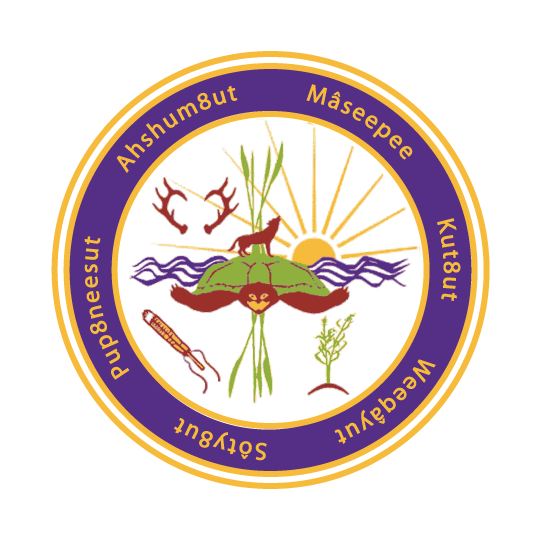The Mashpee Wampanoag are one of three surviving tribes of the original sixty-nine in the Wampanoag Nation.
Contact between Native and non-Native people is often seen as a singular event at a particular point in time. Contact is in fact and ever occurring experience between those surviving indigenous peoples in a place and those who continue to arrive and settle within and around indigenous communities. The following is a snapshot timeline of the contact experience of the Mashpee Wampanoag.
A Brief Timeline of Wampanoag History
By jessie little doe baird
1620: Pilgrims established a settlement on Wampanoag land in Plymouth
1675: King Phillips War. Over forty percent of the Wampanoag tribal population is killed and large number of healthy males sold off as slaves.
1685: Twenty five square miles of land reserved by the Tribe in the form of a deed from tribal leaders to Tribe itself in 1665. Plymouth Colony confirmed this deed in 1685.
1725: Plymouth Colony institutes a proprietary system of land control in Mashpee, with tribal members known as the collective owners of the land, or proprietors.
1746: Plymouth Colony appoints three guardians over Mashpee tribe to limit the Tribe’s independence. Tribe protests repeatedly, to no avail.
1760: Tribe dispatched delegates to meet with the King of England, where they repeated complaints. The King ordered changes in governance.
1763: Plymouth Colony complies with King, acknowledges Mashpee as a self-governing Indian district.
1770: Boston Massacre. Crispus Attucks, a Wampanoag is killed.
1775: Mashpee Wampanoag tribe members fight on behalf of independence in the American Revolution.
1790: U.S. Congress approves the Trade and Intercourse Act, requiring federal approval for Indian land agreements.
1822: Federal officials deliberate on federal Indian removal policy, the federal government denominates Mashpee as a tribe in occupation of a reservation.
1822: For the next twenty-five years, federal officials regularly include Mashpee in federal reports of federal Indian policy. Officials also periodically assess conditions on the Mashpee reservation. Mashpee Tribe and reservation are also referenced on federal lists of tribes in the United States.
1834: Mashpee Wampanoag Tribe protests the authority of non-Indian overseers. Massachusetts Legislature revokes their authority, acknowledging Mashpee as a completely self-governing Indian district.
1842: The Massachusetts Legislature approves the division of Mashpee tribal lands. The land is split among tribal members, making individual property allotments and inalienable to anyone other than Mashpee proprietors. The federal government did not approve this attempted extinguishment of tribal title as required by the 1790 Trade and Intercourse Act. The Commonwealth leaves roughly 5,000 acres of Mashpee land in tribal ownership.
1850: Federal census of tribes is updated and it includes the Mashpee Tribe.
1869: Legislature makes Mashpee Wampanoag tribal members as state citizens and lifts the restraint against alienation of Mashpee allotments to anyone other than other Mashpee proprietors.
1870: Legislature authorized the conveyance of the remaining 3,000 - 5,000 acres in tribal ownership, abolished the Mashpee district, and created the town of Mashpee. The federal government did not approve this transaction as required by the 1790 Trade and Intercourse Act.
1890: U.S. Commissioner of Indian Affairs identifies Mashpee Tribe as one of the few tribes in the eastern United States still in possession of lands.
1904-1916: Mashpee children are sent to the Carlisle Indian School, administered by the Commissioner of Indian Affairs, Department of the Interior, for assimilating tribes.
1870-present time: Mashpee Tribe maintains continuous title to and possession of key tracts of land within the historic Mashpee reservation.
1946: US Navy moves to temporarily condemn Mashpee beach lands for military training and uses, historical documents that show continuously retained aboriginal rights by Mashpee Tribe for water based resources in Mashpee.
1976: The Mashpee tribe files land claim in in federal court.
2007: Mashpee Tribe becomes a federally recognized tribe, authorizing tribe to acquire land and re-establish its Indian Reservation.
2012: Mashpee Tribe files “initial reservation” land in trust application with federal Department of Indian Affairs.
2015: Department of Interior approves Land in Trust Application for “initial reservation”. Tribe begins re-acquiring tribal lands.
2021: The Department of Interior’s Assistant Secretary for Indian Affairs Bryan Newland issued a decision in which he confirmed the status of the Mashpee Wampanoag Indian Tribe's Reservation.




